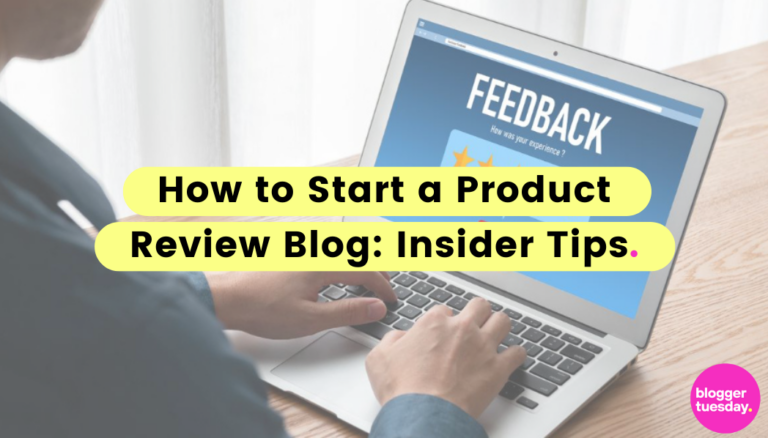In comparison to many other types of blog, a product review blog is more of a serious undertaking. They are a productive way to share your opinions and your interest; they help others make informed decisions; and if done correctly, they can also help you earn an income, including an element of passive income. Whatever it is that you’re passionate about – be it skincare, books, gadgets or a one of a wealth of other niches – starting a product review blog can be fulfilling and rewarding.
In the guide below, we’re going to break down the process step-by-step to help you arrange your thoughts, lay out the groundwork, and begin and grow a successful review blog.
Choosing your niche: Finding the right products
Before you begin to write reviews, defining your niche is essential. There is no end to the list of generalist blogs out there, but niche blogs tend to perform better for a number of reasons. Most importantly, focusing on a specific category helps you to attract a dedicated audience, and will make you more appealing to brands who may be looking for relevant reviewers to affiliate with.
Start by considering your interests and areas of expertise. Are you into beauty products, and bursting to tell people about the skincare trends you think will be the next big thing? Or a tech enthusiast with opinions on the gadgets that are exciting a huge audience? Maybe you’re a stationery nerd and you know there’s a growing trend for content dealing with everything that’s new in the industry. It helps to think this out clearly, because you want a subject that you won’t get bored of researching and writing about.
Next, consider the commercial potential of the niche you’re exploring. Look at the most popular affiliate programs out there, like Amazon Affiliates and similar, to see what’s standing out among in-demand categories. A niche that includes high-value items and brings lots of purchasing interest is more likely to make a profit.
And last but not least, assess the competition. You don’t want the niche to be too crowded, but if you can bring something unique to it – like a local interest, an ethical focus, or a demographic slant, you can still stand out.
Setting up your blog: Essential tools and platforms
Once you’re sure of your niche – and bear in mind that if this takes off, you can always pick another one to start a stable of blogs – it is time to set up your first blog. There are free platforms out there, such as Blogger and Medium, but you’re going to be better off with a self-hosted site which offers far more control and monetisation potential.
It’s also time to decide on your domain name, which may (and probably should) be the same as the blog’s title. Keep it short, relevant, and easy to spell. Then, pick a reliable web host that offers maximal uptime and reliable customer support. Take time to research this, as it’s not easy to change once you’ve picked one.
Once your hosting has been sorted, install your CMS – WordPress is the most popular option – and choose a clean, responsive theme which is well optimised for speed and mobile responsiveness. Themes tend to be customisable, so you can make it fit with your branding. It’s also a good idea to check off the essential plugins for a site that intends to make money.
- Yoast SEO will optimise your online visibility
- Akismet is essential for blocking spam comments – and believe us, you’ll get them
- WPForms is ideal for contact forms
- Pretty Links helps with affiliate link management
The right tools will make management of your blog so much easier in the long run – and getting to grips with them now is infinitely preferable to adding things once the blog is up and running.
Creating engaging content: Tips for writing reviews
Writing informative, engaging product reviews will be the core of what makes your blog better than the others. Your readers will want to know what you’re saying about each new product, so you have to be honest, detailed, and clear.
Structure is important. You will find your comfort zone yourself, but a standard review will follow the pattern below:
- A brief intro to the product – what it is and what it does
- Key specifications – things like size, colour, and how it works
- Pros and cons
- Your personal experience using it
- A final verdict, recommendation, and score – like a letter grade, percentage, or something you devise yourself
Visuals are important, and people will want to see high-quality images – ideally your own for credibility’s sake. If possible, you should embed short video clips showing the product in use. You may also post video clips on YouTube and have your own channel there which augments the blog.
Write as though you are speaking to a friend – don’t sound salesy. Imagine that they have asked you what you think of the product and you’re emailing them a response. Be honest if an item wasn’t up to scratch, although you shouldn’t trash it; you’re looking for a balance between building trust and credibility among readers, and letting potential affiliates know that you’re not going to bury them.
Make everything SEO-Friendly; use relevant keywords naturally throughout the text but especially in the headings and subheads. You want people to be able to find you through search engines.
Building an audience: Strategies for attracting readers
It’s no use writing great reviews if nobody is going to see them – so building an audience is a key part of running a successful blog. SEO is essential in this regard. Choose long-tail keywords your likely readers will be searching for; instead of just “notepad”, go for “best notepad for writers UK”. The Google Keyword Planner is useful for this purpose. And bear in mind that you can use stop words and play with word order. If the above key phrase doesn’t fit in a sentence comfortably, you can use “the best notepad for UK writers”.
Publishing consistently is important too – it is better to post once a week than twice in a week and then not again for a fortnight. Allow yourself as much time as it takes to write quality reviews, rather than rushing to achieve quantity. As your blog gains authority, even the older posts will bring in traffic. Importantly, you should seek reader interaction; ask questions at the end of posts and respond to comments. Use tools like Mailchimp to allow readers to subscribe, too.
Monetising your blog: Effective ways to earn money
Once your blog is attracting traffic, you are in a position to think about monetisation. There are a few ways this can be achieved:
Affiliate marketing is the most straightforward way to monetise a blog. This entails including special links in your reviews; if someone clicks through and makes a purchase, you earn a commission. While Amazon Associates is the common starting point, you can seek out niche-specific networks which will allow you to earn higher commissions.
Display ads are a good source of passive income. If your blog is getting high traffic, then networks like Google AdSense and, as your traffic increases, Mediavine, are useful avenues for this. Sponsored posts, which can be facilitated through Acorn Influence among others, allow you to receive money from companies for posting reviews – just remember that it has to be disclosed when you have been paid to post content.
As your authority grows, also consider creating digital products such as ebooks to maximise your audience, and you can also look at linking an ecommerce site to your blog selling relevant products that are of interest to your readers.
Leveraging social media to boost blog visibility
Social media is an invaluable ally when it comes to spreading the word and building a community around your blog. There’s no harm in being active on multiple social networking sites, but choosing platforms that align with your niche can help.
- Instagram is well suited to beauty, fashion and lifestyle niches
- YouTube is perfect for tech and how-to/tutorial content
- Pinterest is well-liked by bloggers in DIY and home-focused niches
- Twitter/X and Bluesky are useful for networking and industry focuses
Tailor your content to each platform; a blog post can become a script for an Instagram Reel or YouTube short. A Tweet can include a link to your blog or even an affiliate link. And don’t sleep on engagement. Replying to comments, following similar creators, and participating in hashtag conversations can really help build a following
Networking with brands: How to get products for reviews
Working with brands is a natural step once your blog has gained a following. At some point, the brands may come to you, but initially it doesn’t hurt to reach out to them.
Start by building a professional media kit that outlines your blog’s mission and aims, its niche, audience demographics and engagement data. Include a few examples of your best-performing posts, and include some testimonials if you have them. When reaching out, keep your pitch short and focused. Write an email that explains who you are and why you’re a good fit for their products. Explain what you offer – a promotional blog post, social media content, engaging videos) and keep your red lines to a minimum; you want them to say yes.
And although we’ve already said it, we reiterate: always disclose gifted or sponsored products. You have to, by UK law, but if you’re honest and still write insightful, unbiased reviews, your readers’ trust will be ensured.
Take action and start your blog today
Starting a product review blog may seem like a lot to take in, considering the above points, but remember that it doesn’t need to be perfect from day one. Get started at your pace: pick a niche, set up your blog, and get to writing that first review. Everyone starts somewhere.
With time and effort it becomes second nature to manage and improve a blog, and you can build a following, collaborate with brands, and watch your blog grow. The sooner you get going, the sooner your journey can begin – and the greater the degree of opportunity.


